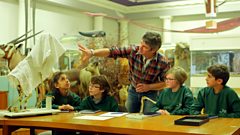
Timeline of life on Earth using fossils as evidence for Evolution
Martin Hughes-Games describes the role of a palaeontologist; someone who studies ancient living things and how planet Earth has evolved over millions of years.
Martin Hughes-Games visits a science museum and explains the different ways that fossils can be formed. He describes the role of a palaeontologist; someone who studies ancient living things and how planet Earth has evolved. Dr Neil Clark, a real life palaeontologist shows a range of fossils including colonial coral found in equatorial regions, crinoids which are sea lilies still alive today and orthocones related to the octopus. He explains how Scotland used to be closer to the Equator but has moved further north over millions of years.
Martin models the evolution of life on Earth in a few minutes using the visual aid of a walk through timeline. From 4.6 billion years ago when the Earth was red hot, the timeline illustrates the evolution of the first life forms through to plants photosynthesising, bacterial evolution, marine life development, dinosaurs, flowering plants, finally leading to human life. Palaeontologists can date the rocks containing fossils so that these fossils can be placed accurately on a timeline to show how a species can change or develop over millions of years. The timeline shows how short a time humans have lived on Earth relative to the rest of the timeline.
Duration:
This clip is from
More clips from Evolutionwatch
-
![]()
How and why some animals have evolved to be better camouflaged
Duration: 04:51
-
![]()
A comparison between broad leaf and pine forest.
Duration: 05:32





